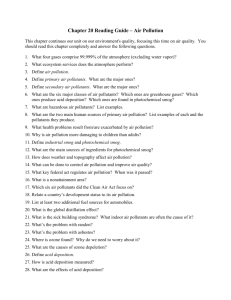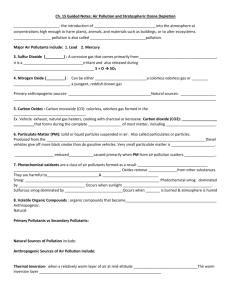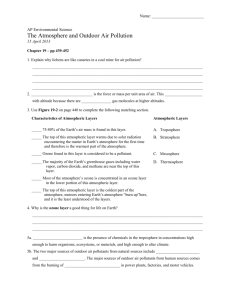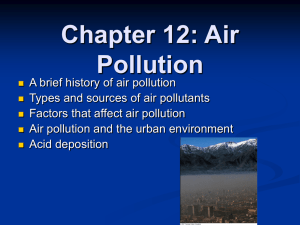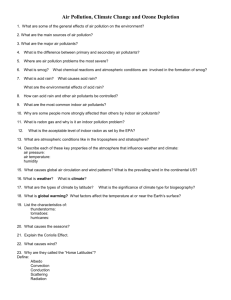PPT: Air Pollution
advertisement
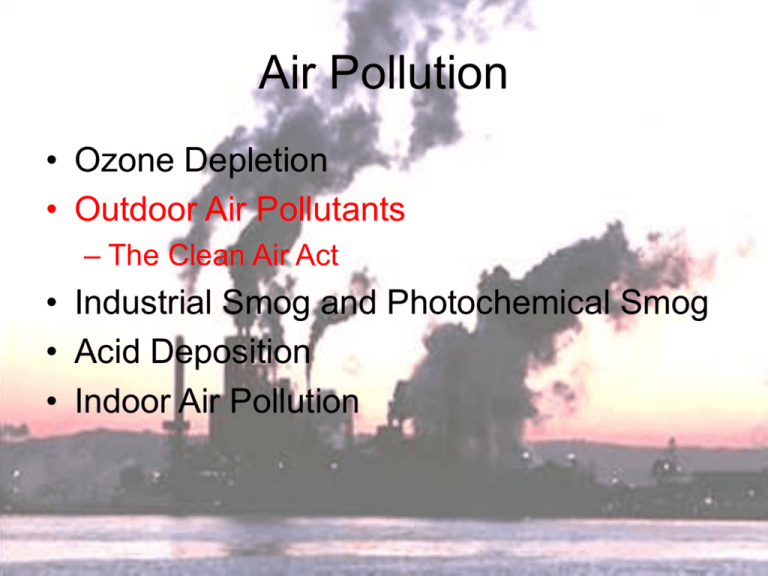
Air Pollution • Ozone Depletion • Outdoor Air Pollutants – The Clean Air Act • Industrial Smog and Photochemical Smog • Acid Deposition • Indoor Air Pollution Outdoor air pollution • Air pollution = material added to the atmosphere that can affect climate and harm organisms, including humans • Air pollution can come from human-made chemicals and causes, but the majority is from natural sources. • Government policy and improved technologies have helped diminish outdoor or ambient air pollution substantially in developed but not developing countries. Natural sources of air pollution dust storms volcanoes fires Artificial sources of air pollution Human-caused air pollution includes: • Point sources = specific spots where large amounts of pollution are discharged (factory smokestacks) • Non-point sources = diffuse, often made up of many small sources (charcoal fires from thousands of homes) Artificial sources of air pollution Human-caused air pollution includes: • Primary pollutants = emitted into troposphere in a directly harmful form (soot, carbon monoxide) • Secondary pollutants = produced via reaction of substances added to the atmosphere with chemicals already present in the atmosphere (ozone in troposphere) Clean Air Act legislation Major air pollution legislation: • Clean Air Act of 1970: • • • • Set stricter standards than previous laws Imposed emissions limits Provided research funds Enabled citizens to sue violating parties • Clean Air Act of 1990: • Strengthened previous regulations • Introduced emissions trading for sulfur dioxide Six “criteria pollutants” The EPA closely tracks six major types of pollutants according to national ambient air quality standards: • Carbon monoxide (CO) • Sulfur dioxide (SO2) • Nitrogen dioxide (NO2) • Tropospheric ozone (O3) • Particulate matter • Lead CO / SO2 / NO2 • Carbon monoxide (CO) = colorless, odorless gas from vehicle exhaust and other sources; dangerous—prevents oxygen uptake • Sulfur dioxide (SO2) = colorless gas from coal burning for electricity and industry; contributes to acid precipitation • Nitrogen dioxide (NO2) = foul-smelling red gas from vehicle exhaust, industry, and electricity generation; contributes to smog and acid precipitation O3 / Pb / particulate matter • Tropospheric ozone (O3) = colorless gas; secondary pollutant from sunlight, heat, nitrogen oxides (NOx), and Ccontaining chemicals; contributes to smog; harmful to living tissues • Lead (Pb) = metal in atmosphere as particulate; from gasoline additive, phased out in 1980s; diverse health impacts, all bad • Particulate matter = any solid (or liquid) particles small enough to be carried aloft in air; dust, soot, sulfates, nitrates; causes respiratory damage Table 20-2 Major Outdoor Air Pollutants CARBON MONOXIDE (CO) Description: Colorless, odorless gas that is poisonous to air-breathing animals; forms during the incomplete combustion of carbon-containing fuels (2 C + O2 2 CO). Major human sources: Cigarette smoking (p. 409), incomplete burning of fossil fuels. About 77% (95% in cities)comes from motor vehicle exhaust. Health effects: Reacts with hemoglobin in red blood cells and reduces the ability of blood to bring oxygen to body cells and tissues. This impairs perception and thinking; slows reflexes; causes headaches, drowsiness, dizziness, and nausea; can trigger heart attacks and angina; damages the development of fetuses and young children; and aggravates chronic bronchitis, emphysema, and anemia. At high levels it causes collapse, coma, irreversible brain cell damage, and death. Table 20-2 Major Outdoor Air Pollutants NITROGEN DIOXIDE (NO2) Table 20-2 Page 438 Description: Reddish-brown irritating gas that gives photochemical smog its brownish color; in the atmosphere can be converted to nitric acid (HNO3), a major component of acid deposition. Major human sources: Fossil fuel burning in motor vehicles (49%) and power and industrial plants (49%). Health effects: Lung irritation and damage; aggravates asthma and chronic bronchitis; increases susceptibility to respiratory infections such as the flu and common colds (especially in young children and older adults). Environmental effects: Reduces visibility; acid deposition of HNO3 can damage trees, soils, and aquatic life in lakes. Property damage: HNO3 can corrode metals and eat away stone on buildings, statues, and monuments; NO2 can damage fabrics. Table 20-2 Major Outdoor Air Pollutants SULFUR DIOXIDE (SO2) Table 20-2 Page 438 Description: Colorless, irritating; forms mostly from the combustion of sulfur containing fossil fuels such as coal and oil (S + O2 SO2); in the atmosphere can be converted to sulfuric acid (H2SO4), a major component of acid deposition. Major human sources: Coal burning in power plants (88%) and industrial processes (10%). Health effects: Breathing problems for healthy people; restriction of airways in people with asthma; chronic exposure can cause a permanent condition similar to bronchitis. According to the WHO, at least 625 million people are exposed to unsafe levels of sulfur dioxide from fossil fuel burning. Environmental effects: Reduces visibility; acid deposition of H2SO4 can damage trees, soils, and aquatic life in lakes. Property damage: SO2 and H2SO4 can corrode metals and eat away stone on buildings, statues, and monuments; SO2 can damage paint, paper, and leather. Table 20-2 Major Outdoor Air Pollutants Table 20-2 Page 438 SUSPENDED PARTICULATE MATTER (SPM) Description: Variety of particles and droplets (aerosols) small and light enough to remain suspended in atmosphere for short periods (large particles) to long periods (small particles; Figure 20-6, p. 441); cause smoke, dust, and haze. Major human sources: Burning coal in power and industrial plants (40%), burning diesel and other fuels in vehicles (17%), agriculture (plowing, burning off fields), unpaved roads, construction. Health effects: Nose and throat irritation, lung damage, and bronchitis; aggravates bronchitis and asthma; shortens life; toxic particulates (such as lead, cadmium, PCBs, and dioxins) can cause mutations, reproductive problems, cancer. Environmental effects: Reduces visibility; acid deposition of H2SO4 droplets can damage trees, soils, and aquatic life in lakes. Property damage: Corrodes metal; soils and discolors buildings, clothes, fabrics, and paints. Table 20-2 Major Outdoor Air Pollutants OZONE (O3) Table 20-2 Page 438 Description: Highly reactive, irritating gas with an unpleasant odor that forms in the troposphere as a major component of photochemical smog (Figures 20-3 and 20-5). Major human sources: Chemical reaction with volatile organic compounds (VOCs, emitted mostly by cars and industries) and nitrogen oxides to form photochemical smog (Figure 20-5). Health effects: Breathing problems; coughing; eye, nose, and throat irritation; aggravates chronic diseases such as asthma, bronchitis, emphysema, and heart disease; reduces resistance to colds and pneumonia; may speed up lung tissue aging. Environmental effects: Ozone can damage plants and trees; smog can reduce visibility. Property damage: Damages rubber, fabrics, and paints. Table 20-2 Major Outdoor Air Pollutants LEAD Table 20-2 Page 438 Description: Solid toxic metal and its compounds, emitted into the atmosphere as particulate matter. Major human sources: Paint old houses), smelters (metal refineries), lead manufacture, storage batteries, leaded gasoline (being phased out in developed countries). Health effects: Accumulates in the body; brain and other nervous system damage and mental retardation (especially in children); digestive and other health problems; some lead-containing chemicals cause cancer in test animals. Environmental effects: Can harm wildlife. Industrial smog Beijing in March 2012 The U.S. had its own “killer smog” from industrial pollution. Shown is Donora, Pennsylvania, in 1948, at mid-day. Subsequent demand for legislation against pollution made U.S. air much cleaner. Six “criteria pollutants” Emissions of all of these, especially lead and carbon monoxide, have substantially declined since 1970. Criteria Pollutants Have Decreased Even as Population and the Economy Have Grown Reasons for the decline in U.S. pollution • Cleaner-burning vehicles and catalytic converters decrease carbon monoxide • Permit-trading programs and clean coal technologies reduce SO2 emissions • Scrubbers = technologies that chemically convert or physically remove pollutants before they leave the smokestacks • Phaseout of leaded gasoline • Improved technologies and federal policies Particulate Removal Technology Toxic air pollutants • Toxic air pollutants = chemicals known to cause serious health or environmental problems • Include substances known to cause cancer and reproductive defects, and substantial ecological harm • Most produced by human activities • 188 toxic air pollutants are regulated under the 1990 Clean Air Act. Air Pollution • Ozone Depletion • Outdoor Air Pollutants – The Clean Air Act • Industrial Smog and Photochemical Smog • Acid Deposition • Indoor Air Pollution Ozone layer • Not really a layer, but a region of higher-thannormal ozone concentrations (which are still very low) • ~17–30 km altitude • Absorbs ultraviolet (UV) radiation from sun, protecting organisms on surface from radiation damage Atmospheric layers Temperature and other characteristic s vary with altitude. Ozone layer Tropopause marks boundary between troposphere and stratosphere. Layers don’t mix. Stratospheric ozone depletion • Ozone at low altitudes = beneficial layer protecting us from UV radiation • Ozone layer— ~ 12 parts per million in lower stratosphere—is enough to absorb UV and protect us. • But in the 1960s scientists noticed ozone concentrations were dropping. Stratospheric ozone depletion The Dobson spectrophotometer, invented in 1924, can infer ozone concentrations from the ground, and helped scientists detect ozone depletion. Stratospheric ozone depletion • In 1985, the “ozone hole” was detected over Antarctica. • Ozone levels had declined 40–60% over the previous decade. Stratospheric ozone depletion Scientists worried about the effects of extra cancercausing UV on people, organisms, ecosystems. The ozone hole (blue) reached its greatest extent in September 2000 (satellite imagery). Stratospheric ozone depletion • In 1974, Sherwood Rowland and Mario Molina pegged the blame on chlorofluorocarbons (CFCs). • They won the Nobel Prize for this scientific detective work. • CFCs = human-made molecules in which hydrogens of hydrocarbons are replaced by chlorine and fluorine atoms • Mass-produced by industry, in refrigerants and consumer products like aerosol sprays Stratospheric ozone depletion CFCs persist in the stratosphere. They split oxygen atoms off ozone (O3) to form oxygen (O2). 1 Cl atom can split many O3 molecules CFC – Ozone Reaction Stratospheric ozone depletion • In 1987, over 180 nations signed the Montreal Protocol, which restricted CFC production globally. • Follow-up agreements strengthened the pact. • Today CFC levels are down, and stratospheric ozone is starting to recover. • The Montreal Protocol is one of the biggest environmental success stories of our time. • We have apparently avoided a major environmental problem. Stratospheric ozone depletion Reasons for success of the Montreal Protocol: • Government and industry cooperated on finding solutions (cheap replacement technologies for CFCs), so battles typical to environmental debates were minimized. • Protocol was implemented with “adaptive management”—ability to fine-tune actions as time goes on, in response to new data or conditions. Effect of Montreal Protocol •Agriculture and Ozone Depletion Air Pollution • Ozone Depletion • Outdoor Air Pollutants – The Clean Air Act • Industrial and Photochemical Smog • Acid Deposition • Indoor Air Pollution Industrial smog Photochemical smog • 17.16 Industrial smog • Smog from industrial pollution, fossil-fuel combustion • The kind that blanketed London in 1952 • “Gray air smog” • Contains soot, sulfur, CO, CO2… Industrial smog Beijing in March 2012 The U.S. had its own “killer smog” from industrial pollution. Shown is Donora, Pennsylvania, in 1948, at mid-day. Subsequent demand for legislation against pollution made U.S. air much cleaner. Industrial smog Chemistry of industrial smog: • Burning sulfur-rich oil or coal creates SO2, SO3, sulfuric acid, ammonium sulfate. • Carbon leads to CO2 and CO. Photochemical smog • Smog from reaction of sunlight with pollutants • The kind that blankets so many American cities today • “Brown air smog” • Contains tropospheric ozone, NO2, VOCs, 100 more… • Hot sunny days in urban areas create perfect conditions. Volatile organic compounds • “VOCs” are regulated by many governments. • Large group of potentially harmful carboncontaining chemicals used in industrial processes. • Hydrocarbons are one example. • About half are human-made, half natural. • VOCs contribute to smog, produce secondary pollutants. Photochemical smog Chemistry of photochemical smog: • Nitric oxide starts a chain reaction. • Reaction with sunlight, water vapor, hydrocarbon, results in over 100 secondary pollutants. Causal Loops and Leverage Photochemical smog • Mexico City and many of the world’s cities suffer from the brownish haze of photochemical smog. • Inversion layers and mountains can trap smog over certain cities. Thermal inversion • Usually, tropospheric air temperature decreases as altitude increases • Warm air rises, causing vertical mixing • Thermal inversion = a layer of cool air occurs beneath a layer of warmer air • Inversion layer = the band of air in which temperature rises with altitude • Denser, cooler air at the bottom of the layer resists mixing Thermal inversion • Usually, tropospheric air temperature decreases as altitude increases – Warm air rises, causing vertical mixing • Thermal inversion = a layer of cool air occurs beneath a layer of warmer air – Inversion layer = the band of air in which temperature rises with altitude – Denser, cooler air at the bottom of the layer resists mixing Viewpoints: Air pollution Debra Knopman “Simply tightening regulations…is unlikely to significantly reduce smog… Emissions trading is an economically attractive supplement to current technology-based regulations.” David McIntosh “Without additional [regulatory] measures, 20 million people will live in areas exceeding EPA’s smog standard in 2015…there is a lot of work to do.” Air Pollution • Ozone Depletion • Outdoor Air Pollutants – The Clean Air Act • Industrial and Photochemical Smog • Acid Deposition • Indoor Air Pollution Acid deposition • Acidic deposition = deposition of acidic or acid-forming pollutants from the atmosphere onto the Earth as acid rain, acid fog, acid snow • One type of atmospheric deposition • Caused by reaction of pollutants like SO2 and NO with water, oxygen, and oxidants resulting in sulfuric acid or nitric acid • Can have wide-ranging detrimental effects on ecosystems and the built environment Acid deposition Acid deposition is created by reactions in the atmosphere, and can fall many miles from where pollution originated. The Chemical Reactions that Form and Neutralize Acid Precipitation Acid deposition Acidity varies geographically. (Orange = more acidic) Industrialized areas and regions downwind of them suffer most. Areas with Limestone Bedrock are less acidic. Acid deposition It also eats away at statues and buildings. Acid deposition Acid deposition has killed these conifer trees in the mountains of North Carolina. Acid deposition Acid precipitation harms soil and plants, and alters the chemistry of ecosystems . © Martin Kennedy, University of California-Riverside. Acid Deposition, Plants, and Soil Nutrient leaching Heavy metal release Weakens trees Fig. 20-11 p. 447 Acid deposition Acid deposition has killed these conifer trees in the mountains of North Carolina. Acid deposition Following the 1970 Clean Air Act, • Sulfur emissions have decreased due to: • Technology (“scrubbers”) to clean smokestacks • Legislation and a market-based emissions trading scheme • But nitrate pollution has risen slightly, and acidification is not being reversed as many had hoped. Particulate Removal Technology Acid deposition This can be seen in data from New Hampshire’s Hubbard Brook Experimental Forest, where acid rain was first studied. pH has increased (rain has become less acidic) since 1970, but is still much more acidic than normal rain. Solutions to Acid Deposition Fig. 20-12 p. 448 Air Pollution • Ozone Depletion • Outdoor Air Pollutants – The Clean Air Act • Industrial and Photochemical Smog • Acid Deposition • Indoor Air Pollution Indoor air pollution • Indoor air spaces generally have MORE pollution than outdoor spaces. • U.S. citizens spend 90% of time indoors. • Countless consumer products and synthetic chemicals kept indoors are used in our daily lives. UN estimate for world: • 2.2 million deaths/year from indoor air pollution • 0.5 million deaths/year from outdoor air pollution Indoor air pollution More disease from indoor (orange) pollution than outdoor (red) In developing nations, indoor cooking fires are common, and a major health risk. Indoor air pollution • In developed nations, the 2 biggest threats seem to be: • Cigarette smoke: lung cancer risk for smokers and those inhaling secondhand smoke • Radon: naturally occurring colorless, odorless gas; radioactive—seeps up from ground and collects in buildings; lung cancer risk • Radon varies in its occurrence, depending on an area’s underlying geology. • It is best to have your home tested for radon. Radon Indoor air pollution risks in the home Other indoor air pollution sources • Many VOCs pollute indoor air (plastics, oils, cleaning fluids, adhesives, pesticides, building materials). • Tiny living organisms (dust mites, animal dander, fungi, mold) can produce indoor air pollution, causing allergies, asthma, etc. • When the cause of building-related illness is a mystery, the illness is often called sickbuilding syndrome. Reducing indoor air pollution • Buy and use low-toxicity products • Provide good ventilation • Limit exposure to plastics, treated wood, pesticides, cleansing fluids (put in garage, not home) • Test home for radon • Test drinking water for lead from pipes • In developing world, provide ventilation, install clean-burning stoves, shift to gas Conclusion • Indoor air pollution is a potentially serious health threat. • Outdoor air pollution has been addressed more effectively by government legislation and regulation. • There is much room for improvement in reducing acidic deposition and photochemical smog. • This will continue to pose a challenge as lesswealthy nations industrialize.


